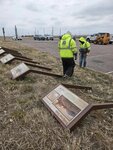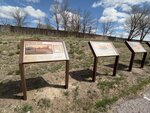

GOSHEN COUNTY – There is no doubt about it, Goshen County is full of history. With the Oregon Trail, Cheyenne Deadwood Stage Route, Mormon Trail, Pony Express, and the Texas Trail all winding through the valley, it is no wonder the more than 650 historic markers and memorials along the Oregon Trail Historic Scenic Byway attract people from miles around.
Archaeologist George Zeimens and his wife Geri have been preserving, discovering, and maintaining the history of Goshen County and beyond for much of their adult lives. On Thursday, May 2 the Zeimens’ and a large crew of collogues and friends invite the public to attend the dedication of five historic painting highway marker signs, Geri’s innovation.
The signs, all hand painted by Torrington native, Barbara Schaffner, are an illustration of the historical events which took place from the Wyoming state line to the Fort Laramie Military Post. Schaffner, who now resides in Wheatland, utilized the expert opinion and perspective of George and other historians to design the illustration on each of the marking signs.
“When I was approached by Geri and George Zeimans with a request to paint five paintings to be used for highway marker signs telling of historic events that happened from the Wyoming state line to Fort Laramie Military Post, I offered to help immediately,” Schaffner said. “I have always felt there were important stories here that needed to be told, and there was a guiding hand that brought this project to me.”
According to Schaffner, the paintings, located at the Lingle Rest Stop along US Highway 26, approximately 1.5 miles east of Lingle, were not intended to be fully referenced or footnoted mentioning the resources used to design the painting were stacks of books, articles, photos, journals, and online sources.
“Acclaimed archaeologist George Zeimens was my most important resource,” Schaffner said. “We visited the location of each site. Here he shared the information of his findings and hours of work in the area. He explained building structures and placement and how the trails accessed them. His knowledge and discoveries helped me to get a feel for the area and the events that happened there. I wish you could have been there. It was like stepping back in time.”
The illustrations depict Fort Bernard, which was established in the early 1840s, in Schaffner’s “The Art of The Trade.” The fort was later purchased by the American Fur Company in 1850.
“The trading posts dealt mainly in the hide and fur trade with the Indian tribes. They serviced the pioneers traveling westward on the pioneer trails, providing blacksmiths to repair their worn-out wagons, replacements for their draft animals, and replenishing their supplies for an exorbitant price,” Schaffner explained.
The Oregon Trail ran alongside the fort, according to Schaffner’s research, where the Gratiot house was built in the early 1850s. The house was used to store amenities offered by the government to Indian tribes.
In the painting, Schaffner offers a historical view of the trader’s wife greeting a family.
“By the mid-1850s non-military trading posts, often called forts, sprang up along the emigrant trails to serve travelers and tribes,” the sign reads below Schaffner’s illustration. “Eventually there were posts every five to ten miles from Scotts Bluff to Fort Laramie.”
In the illustration, “One Step at a Time,” Schaffner portrays the Emigrant Trail which included the Oregon, Mormon, and California Trails. The painting portrays life on the Oregon Trail where trailers made their homes in Conestoga wagons, leaving home with a milk cow and a good draft team of oxen.
“Diary stories told of arriving at Fort Laramie, worn out, some very sick, and needing supplies, and seeing Laramie Peak ahead which was a harbinger of the mountain travel ahead. The easy part was over now,” Schaffner said.
A stray cow belonging to a Mormon traveler was eaten by a young Miniconjou Lakota named High Forehead, according to Schaffner’s research.
“The Mormon went to Fort Laramie wanting restitution. Matters like that should have been handled by the Indian agent who was not there. Lieutenant Grattan, a recent graduate of West Point, was sent to take care of the matter. He unwisely went into a Brule Sioux camp of over four thousand people with a force of 29 infantry and a drunken interpreter,” Schaffner explained. “Here he demanded High Forehead. Chief Conquering Bear offered a horse and a mule to pay for the cow. Lt. Grattan insisted on taking High Forehead instead. During the talk, a cannon shot over the encampment mortally wounding Chief Conquering Bear infuriating the rest of the tribe. In ten minutes, all the infantry and others were dead. Yes. It was a high price to pay for a cow and a lieutenant’s arrogance.”
Also illustrated by Schaffner was “In His Glory,” showcasing the history of Rock Ranch and Ash Point, where 89 Sioux Indiana raided a horse herd. Of the nine cowboys, three were killed along with 19 Indians.
Schaffner also illustrated “To Build an Empire,” which shows a herd of Spanish longhorn cattle and Spanish mustangs which trailed the Texas Trail.
“After the Civil War, Texas overflowed with millions of surplus cattle and no local market,” the inscription reads below Schaffner’s artwork. “Soon, drovers began driving large herds north to end-of-tracks towns with railroad like Abilene and Dodge City, Kansas.”
“Getting to work on these paintings has been the most rewarding experience. As I immersed myself in the research, the stories that I uncovered left me in awe. I feel honored that I got to play a part in bringing these important events to life for others to learn about them,” Schaffner expressed. “It took the whole committee working together to get this done. Hopefully, I have helped pay tribute to these courageous, and resourceful individuals who were part of the saga of opening up our nation’s western frontier. Their struggles, sorrows, goals, and perseverance are encouraging to all of us. They need to be remembered.”
Dan Bach, Wyoming State Parks Service Monuments and Markers Coordinator was a key component for the highway signs when the project was transferred to the park service in 2017. Upon the transfer of the project, Bach assumed the lead.
“Geri Zeimens approached me in August of 2020 with the idea of creating five signs and placing them at the old Lingle rest stop owned by WYDOT (Wyoming Department of Transportation),” Bach explained. “She filled out the applications and we looked them over and they looked good. We have certain themes for our signs here in Wyoming. They included, the big ones of course, ‘The First People’, ‘The Push West”, “On the Range,” “Boom and Bust and ‘Building Communities’ and her signs marked off two of those boxes, push west and first people.”
Bach further explained the biggest struggle wasn’t the permits and fabrication of the signs, it would be something much more common.
“The hardest part was actually just working on the text,” Bach explained. “That took the longest time. It went through multiple versions and the other thing that really was fascinating and really neat is Barbara did all the artwork for these five signs. That took a year or more.”
Projects like this normally take a year or two to complete according to Bach, however, like many things, the signs were put on hold during the COVID-19 pandemic.
“Covid hit and that just killed us,” Bach explained. “But we got it done. My job as the coordinator is to make sure we have all of our permits in order, so Geri reached out to WYDOT and we got the right-of-way permit signs,” Bach said.
Grant programs helped to fund the signs, according to Bach.
“I am so thankful for Goshen County and their grant program to pay for these signs,” Bach said.
“Hopefully, I have helped pay tribute to these courageous and resourceful individuals who were part of the saga of opening our nation’s western frontier. Their struggles, sorrows, goals, and perseverance are encouraging to all of us. They need to be remembered,” Schaffner said.
The community is invited to attend the dedication of these historical signs on Thursday, May 2 at 2:00 p.m. at the Lingle rest stop turn out, approximately 1.5 miles east of Lingle. Special attendees will include George Zeimens, Barbara Scaffner, and representatives from the Wyoming Department of State Parks & Cultural Resources, and the Wyoming Dept. of Transportation. A reception, hosted by both Goshen and Platte County Historical Society’s will follow at the Lingle Community Center.